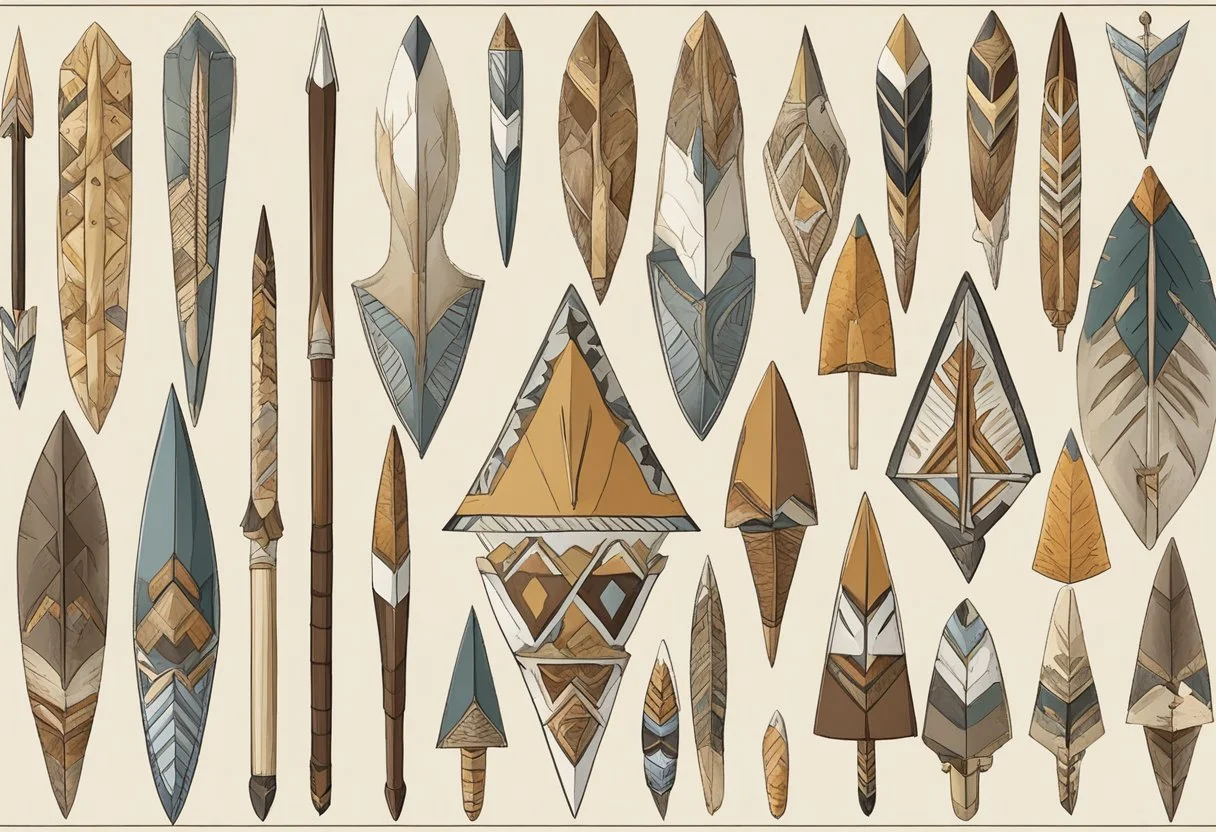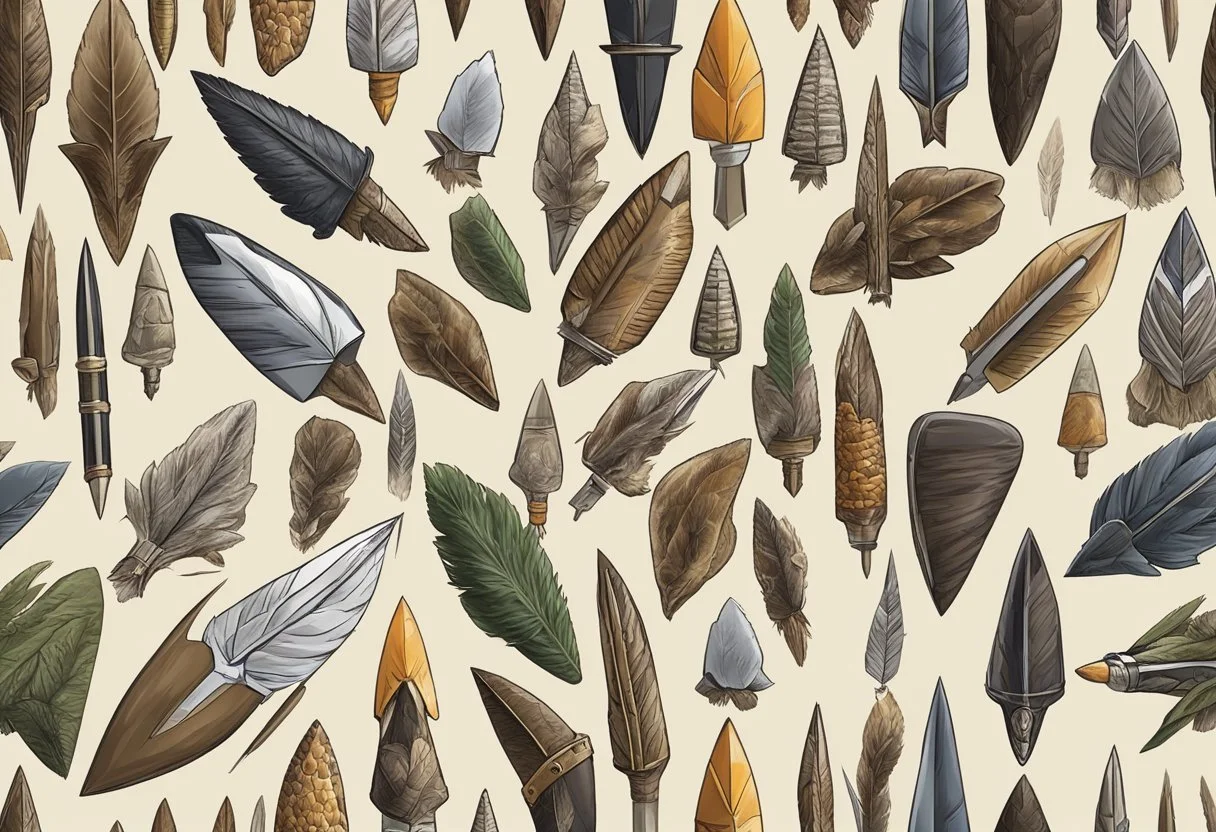Best Arrowheads for Hunting
Top Picks and Buyer's Guide
Discover > Hunting Gear > Best Arrowheads for Hunting
The art and sport of hunting have long been enhanced by the use of arrowheads. With their historical significance and numerous modern adaptations, choosing the best arrowheads for hunting may seem like a daunting task. However, understanding the key factors that contribute to a successful hunt can simplify this decision-making process.
One important aspect to consider when selecting arrowheads is the type of game being targeted; different shapes and materials are best suited for specific animals. For instance, broadheads have an advantage when hunting large game, while small game hunters might prefer blunt arrowheads.
Additionally, the quality and accuracy of an arrow is crucial in hunting. Arrows made from carbon-fiber provide the best-shooting and highly practical solution, as they offer consistency in spine, straightness, and weight tolerances. Making an informed choice about arrowheads, combined with the proper research on hunting techniques and locations, will undoubtedly lead to a more productive and enjoyable experience in the outdoors.
Understanding Arrowheads
The Role of Arrowheads in Hunting
Arrowheads play a crucial role in the world of hunting. They are specifically designed to ensure the quick, humane dispatching of game, while maximizing the chances of a successful hunt. There are different types of arrowheads, and each has specific attributes that can make them more suitable for hunting particular types of game.
Bullet points: These arrowheads are specialized for small game hunting and varmint control, featuring a small, rounded shape that minimizes tissue damage and preserves the game meat.
Broadheads: Designed for big game hunting, such as deer, these arrowheads create large wound channels to increase the chances of a successful kill.
Arrowheads vs. Broadheads
In the world of archery, the terms "arrowheads" and "broadheads" are sometimes used interchangeably, but it is important to understand the differences between them.
Arrowheads refer to the general category of tips that can be attached to an arrow's shaft for hunting purposes. They can include various styles, like bullet points and broadheads, among others.
Broadheads, on the other hand, are a specific type of arrowhead. They tend to be heavier than other styles because of their thicker blade edges, but they offer improved penetration power and increased accuracy at long-range shots. Broadheads come in two main types:
Fixed blade broadheads have rigid, fixed blades that do not move. They are known for their durability and ability to maintain their cutting edge.
Mechanical broadheads feature blades that deploy upon impact with the target, allowing for a larger cutting diameter and potentially increasing the chances of a successful kill.
When choosing between arrowheads and broadheads, hunters should consider their intended target, hunting scenario, and their individual archery setup. Factors such as arrow weight, arrow flight trajectory, and penetration power play a significant role in determining the best choice for each hunter.
Types of Arrowheads for Hunting
When it comes to hunting, choosing the right arrowhead is crucial for success. There are several types of arrowheads designed for specific purposes, but the two most common types for hunting are fixed blade arrowheads and mechanical arrowheads. These broadheads serve different goals and suit different hunting situations. In this section, we'll explore both types and their characteristics to help you choose the best arrowhead for your needs.
Fixed Blade Arrowheads
Fixed blade arrowheads are designed with a single cutting surface, usually made of metal or plastic, that remains constant throughout flight and impact. They are a popular choice among hunters, particularly for big game hunting, as they possess strong penetration capabilities and are known for their reliability and durability.
Fixed blade broadheads come in various designs and shapes, with some featuring:
Cut-on-contact tip: This tip has an extremely sharp edge that pierces the animal's skin efficiently upon contact.
Chisel tip: The chisel tip features a pointed, flat edge, which is robust and helps in breaking bones for greater penetration.
One key aspect to consider when selecting a fixed blade arrowhead is weight, which plays a role in kinetic energy and accuracy. Arrow weights are measured in grains, with most arrows ranging from 7 grains per inch (gpi) to 12 gpi. Depending on your preferences and the game you're hunting, the right weight may vary.
Browse Fixed Blade Arrowheads here
Mechanical Arrowheads
Mechanical arrowheads, also known as expandable broadheads, have blades that remain closed during flight and only open upon impact. This design reduces wind resistance and leads to improved accuracy. Mechanical broadheads are typically recommended for hunting smaller game or when longer-range accuracy is critical.
There are two main types of mechanical arrowheads:
Rear-deploying: The blades of these arrowheads are hinged at the back, allowing them to expand upon impact.
Over-the-top deploying: In this design, the blades are hinged at the front and expand when the arrowhead makes contact with the target.
While mechanical arrowheads are generally more accurate due to their streamlined profile, they may require more maintenance and are sometimes prone to mechanical failure. However, do note that designs have come a long way, and many modern expandable broadheads are both reliable and efficient.
Ultimately, the choice between fixed blade and mechanical arrowheads comes down to personal preference and the type of game you intend to hunt. It is crucial to carefully consider the pros and cons of each type and experiment with both to determine which one suits your needs and hunting style better.
Browse Mechanical Arrowheads here
Choosing the Best Hunting Arrow
Arrow Material
There are two primary materials used in manufacturing hunting arrow heads and shafts: carbon and aluminum. Carbon arrows are lightweight, fast, and offer excellent accuracy. They have a higher tolerance for impact, making them less susceptible to bending or breaking. Aluminum arrows are heavier and provide more kinetic energy, which can improve penetration on larger game animals. However, aluminum arrows are more prone to bending and may require straightening after heavy use.
Arrow Straightness
Arrow straightness is an essential aspect of arrow selection and is usually measured in thousandths of an inch (e.g., .003" or .006"). A higher degree of straightness results in better accuracy and consistency in flight. When selecting arrows, choose shafts with a straightness rating that matches your desired level of accuracy and budget. Keep in mind that as you improve in your shooting ability, you may demand higher straightness tolerances.
Arrow Weight
Arrow weight plays a significant role in the performance of a hunting arrow. It affects the arrow's flight, penetration, and kinetic energy. Arrow weight is often measured in grains per inch (gpi). Heavier arrows provide better penetration and momentum but may sacrifice some speed, while lighter arrows are faster but may lose energy quickly.
Heavy arrows (10-12 gpi): Suitable for larger game and longer distances, offering better penetration and momentum.
Medium-weight arrows (8-10 gpi): A balance between speed and energy, appropriate for various hunting situations.
Light arrows (7-8 gpi): Fast and flat-shooting, resulting in a smaller drop and better accuracy in range estimation. Suitable for smaller game or shorter distances.
Experimenting with different arrow weights can help you find the right balance between speed, accuracy, and penetration for your hunting needs. Remember that factors such as arrow length, bow poundage, and point weight will also affect the overall weight and performance of your hunting arrow.
Enhancing Your Hunting Skills
Bow Hunting Techniques
Bow hunting requires mastering a variety of techniques to become a proficient bowhunter. The first step is to perfect your stance and grip on the recurve bow. Maintain a relaxed grip while keeping your bow arm slightly bent at the elbow to ensure stability.
Next, focus on the basics of improving your draw and anchor point. The draw should be smooth and consistent, while the anchor point serves as the reference position where the bowstring connects with the corner of your eye, mouth or cheek. This ensures accuracy and reduces the risk of injury.
Lastly, work on developing a solid release technique. A smooth release with a proper follow-through will significantly increase your chances of a successful shot. To practice your release, consider using a release aid designed specifically for bow hunting, as it provides a consistent release point and allows for better control of the bowstring.
Understanding Your Tools
Having a comprehensive understanding of your bowhunting tools and equipment is essential for success in the field. Familiarize yourself with the different types of arrows and arrowheads available for various game. For instance, mechanical broadheads are ideal for deer hunting, while fixed-blade broadheads may be more suitable for larger game.
In addition, consider the following factors when selecting arrows for hunting:
Shaft Material: Carbon arrows are popular for their durability, accuracy, and lightweight properties. They are excellent for deer and elk hunting.
Weight: Heavier arrows tend to be quieter and penetrate better, making them a good choice for whitetail hunting.
Length: Choose the appropriate arrow length based on your draw length and the type of bow you are using. A properly sized arrow will ensure a safe and accurate shot.
Furthermore, outfit yourself with essential bowhunting equipment such as:
Bow sight: A device mounted on your bow to help improve accuracy.
Quiver: A container for holding and organizing arrows.
Armguard: A piece of protective gear that covers the forearm to prevent injury from the bowstring.
Bow sling: Used to secure the bow to your body, freeing up both of your hands for other tasks.
By these tips on honing your bow hunting tips and techniques and understanding the tools at your disposal, you can enhance your hunting skills and boost your chances in many areas of success in the field.
Historical Perspective
Arrowheads and Native American Tribes
Throughout history, arrowheads have played a significant role in the hunting practices of Native American tribes. These tools, crafted from stone, bone, and metal, were not only used for hunting but also as symbols of warfare and religion. As technology advanced and tribal priorities shifted, so did the design and functionality of arrowheads.
Early Native Americans crafted arrowheads from locally available materials, relying primarily on stones such as flint, obsidian, and chert. These materials were chipped and ground to form sharp edges, which were then further ground and refined to create the arrowhead shapes we recognize today. Some common forms include:
Clovis points: Associated with the ancient Clovis culture, these fluted points were used for large game hunting.
Bird points: Small, lightweight arrowheads designed specifically for bird hunting.
Fish points: Barbed arrowheads used for fishing, with a shape that enabled easy retrieval of prey.
As tribes across North America developed their own distinct cultures, so did their arrowheads. Here's a brief overview of arrowheads from some major Native American tribes:
Apache: Their arrowheads were typically small and triangular, ideal for hunting smaller game and bird species.
Comanche: Arrowheads often featured broad, flat bases with deep notches for efficient penetration and target impact.
Cherokee: They crafted large, broad arrowheads featuring serrated edges, perfect for hunting larger game.
As the Native American tribes advanced, they continued to develop how to improve the efficiency and effectiveness of their arrowheads. This progression eventually led to the use of metals, such as copper and iron. Metal arrowheads offered a higher level of durability and precision in comparison to their stone counterparts.
In modern times, the fascination with Native American artifacts and wildlife endures, with the country and numerous enthusiasts and collectors searching for these pieces and artifacts of cultural history. Arrowhead hunting has become a popular outdoor activity, allowing people to connect with the past and experience the ingenuity of early human technology.
Overall, the historical perspective on arrowhead usage among Native American tribes reveals a diverse and constantly evolving understanding of tool creation and usage. These carefully crafted instruments continue to inspire admiration and fascination in today's world.
Advanced Arrow Features
Fletching and Stabilization
Fletching plays a crucial role in the flight and stability of an arrow. Typically made from plastic vanes or natural feathers, fletchings create drag and generate spin, helping to stabilize the arrow in flight. The choice of fletching material and size depends on the hunter's specific needs and preferences.
Plastic Vanes: Known for their durability and water resistance, plastic vanes provide consistent stabilization. They come in various sizes and shapes, with shorter, low-profile versions offering enhanced speed and less wind drift, while longer, high-profile ones deliver better stability and accuracy.
Feather Fletching: Traditionally made from turkey feathers, feather fletchings offer a lighter weight option with superior forgiveness and improved arrow flight characteristics at shorter distances. They are particularly suitable for traditional archery and hunting in dense forests with minimal wind interference.
Moreover, the fletching's helical orientation can impact arrow stabilization. Helical fletching, which twists around the arrow shaft, induces a stabilizing rotational force, improving accuracy and reducing the arrow's sensitivity to crosswinds. However, they may produce slightly slower speeds due to increased surface drag.
Get the best fletching tools and accessories here
Arrow Spine
The arrow spine refers to the stiffness of the arrow shaft and is an essential aspect of arrow performance. It's crucial to select the appropriate spine for a particular bow setup, as an improperly matched spine can result in poor accuracy and flight characteristics.
For hunting arrows, the spine requirements usually fall within two categories:
Stiffer Spines: Required for higher draw weight bows, stiffer spines ensure that arrows maintain their structural integrity during the high-energy release. This results in consistent accuracy and penetration power.
Softer Spines: Ideal for lower draw weight bows or traditional archery setups, softer spines provide better flexibility and forgiveness. They can, however, be less accurate at longer distances or with heavier broadheads.
To determine the ideal arrow spine for a specific bow setup, it's essential to consult the manufacturer's spine selection chart or seek advice from a professional archery shop.
Additionally, the front-of-center (FOC) balance point, which refers to the percentage of the arrow's total weight located forward of its center, can influence arrow flight and penetration. Higher FOCs might improve stability, accuracy, and penetration power, particularly at longer distances and with larger game.
Understanding Hunting Arrows from Various Brands
Insights into Easton Arrowheads
Easton is a well-recognized brand in the archery world, known for producing high-quality hunting arrows. A standout product in their lineup is the Easton 4mm Axis Long Range. This arrow revolutionized the small shaft design, allowing for better accuracy, deeper penetration, and reduced wind drift. The tight tolerances in spine, straightness, and weight contribute to its consistent performance, making Easton arrowheads a reliable choice for hunting.
When it comes to durability, Easton offers products like their FMJ (Full Metal Jacket) arrows, which are designed for heavy-hitting and provide increased momentum during the shot. The combination of carbon core and metal jacket makes these arrows not only accurate but also extremely strong and durable.
Overview of Gold Tip Arrowheads
Gold Tip is another reputable brand with an excellent track record in producing hunting arrows. One of their notable products is the Gold Tip Hunter XT, which has been recognized as one of the best arrows for the money. This arrow is designed with a focus on accuracy and durability, providing a balance of performance and value for hunters.
Some features of Gold Tip arrowheads include:
Lightweight design: Ensures a swift, accurate flight
Versatility: Suitable for various types of game
Durability: Made from high-quality materials to withstand tough conditions
Hunters searching for a reliable combination of accuracy and durability without breaking the bank should consider Gold Tip arrowheads as a solid option.
Features of Black Eagle Arrowheads
Black Eagle is another brand worth mentioning for their quality hunting arrows. They offer a range of various arrow heads and products, catering to different hunting needs and preferences. One of the standout features of Black Eagle arrowheads is their attention to detail in crafting high-performance arrows.
A few advantages of using Black Eagle arrowheads include:
Precision manufacturing: Provides consistently accurate shots
Weight and spine consistency: Enhances accuracy and flight stability
Durable construction: Ensuring long-lasting arrow performance
Overall, Black Eagle arrowheads offer great options for those who prioritize accuracy and durability in their hunting experience.
Closing Thoughts
When considering the search for best arrowheads for hunting, quality, performance, and price are essential aspects to keep in mind. A well-informed decision will ensure an enjoyable and successful hunting experience.
In terms of quality, search for arrows boasting tight spine, straightness, and weight tolerances. This ensures consistency and accuracy in flight, which is crucial for effective hunting. Durability is another essential factor, as arrows must withstand the rigorous conditions of hunting environments.
For performance, each type of game requires specific arrowheads to maximize effectiveness. Smaller game calls for lightweight, fast-flying arrows, while larger game benefits from heavier arrows with deeper penetration capabilities. Considering factors such as kinetic energy, noise reduction, and distance will ultimately influence which arrow best suits the intended quarry.
Finally, price plays a vital role in the selection process. Affordable options such as Gold Tip Hunter XT offer excellent value without sacrificing quality. Higher-priced options may provide more specialized features, like the Easton 5mm Axis for overall hunting performance or the Black Eagle X Impact for long-range shooting.
In conclusion, it is crucial for hunters to weigh the pros and cons of various arrowhead options, taking into account factors such as quality, performance, last life and price. By evaluating these aspects and making an informed decision, hunting enthusiasts can optimize their experience and success in the field.





